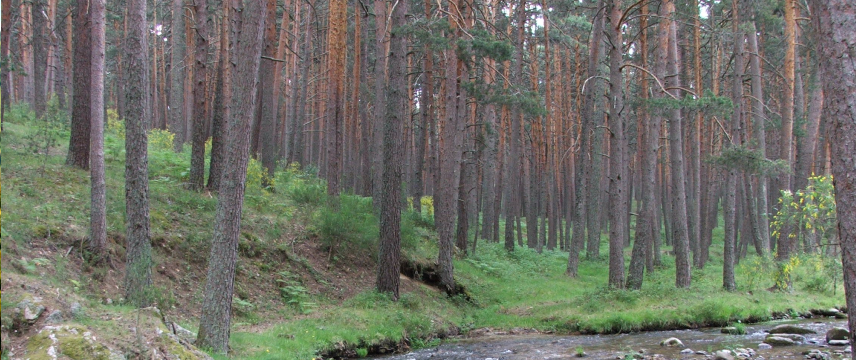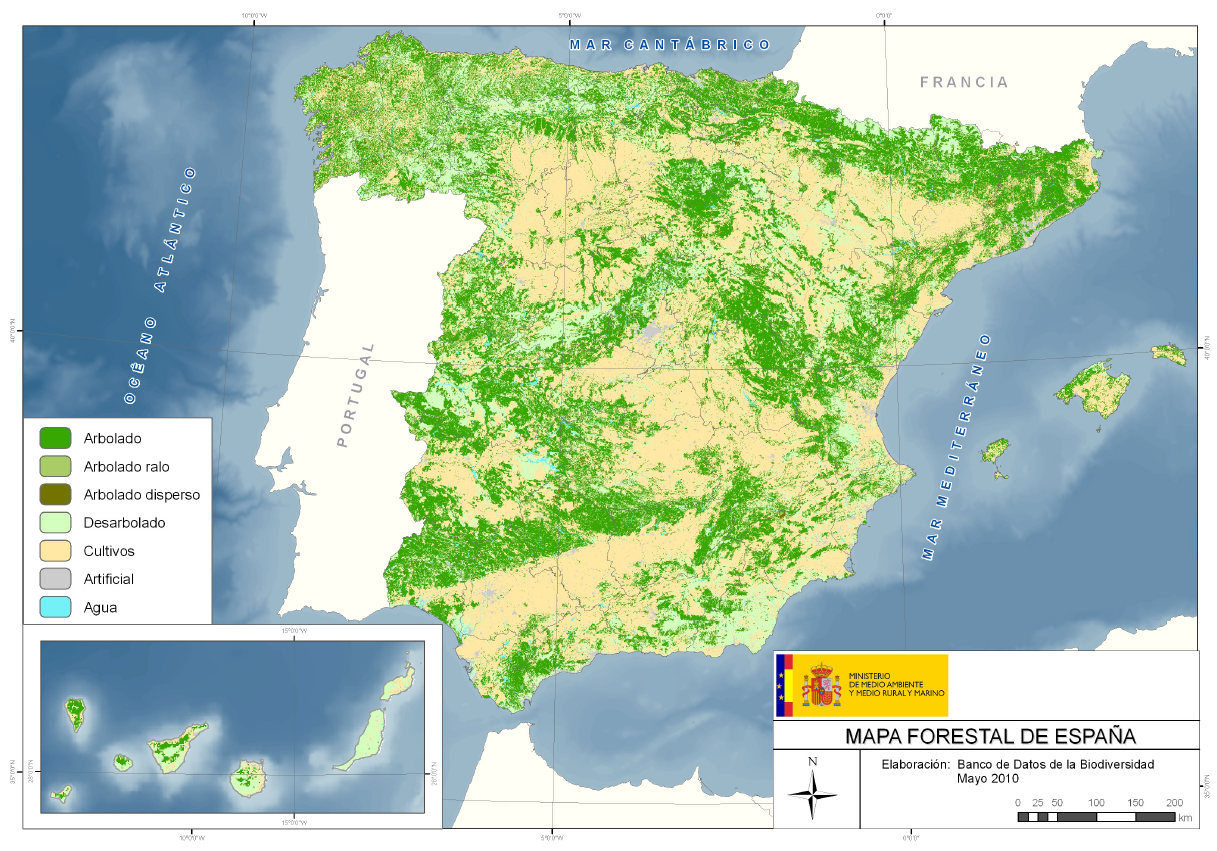Natural areas in Spain

Soil properties determine how different species can grow and if the species can live better than other species. In comparison with agricultural soils, forest soils are usually less fertile, lower in depth and stonier in consistency. It is crucial that the loss of the fine earth fraction of the soil is avoided and that the soil structure is not altered due to the lack of or inadequate forest management. Human management activities that can negatively impact forest soils are species selection for new forests and soil preparation techniques, as well as thinning and harvesting. However, these activities can also guarantee an improvement in soil conditions if they are carried out in a sustainable way.
Spain has a great forest diversity. Its orography and climatology have led to a wide variability of ecosystems, which has caused the types of forest present in Spain to differ considerably both from North to South, as from East to West, and in the Atlantic islands in particular. The forest ecosystems of Spain occupy just over 26 million hectares, of which almost 15 million are wooded and about 12 million treeless. These areas respectively account for 29% and 23% of the national territory. Coniferous forests have a similar extension to the leafy ones (5,7 and 5,2 million ha, respectively) while the mixed forests populate somewhat less (3,9 million ha).
As far as the ecological domain is concerned, forests in Spain can be split into four generic types based on their respective geographical areas in Spain. In this way we can make a classification into Mediterranean Forest, Atlantic Forest, Alpine Forest, and Macaronesian Forest
Among the leafy group trees, the species with the greatest presence in the area is Quercus ilex, followed by Q. pyrenaica and Q. pubescens, Eucalyptus spp. and Q. suber. The species with the greatest territorial occupation among conifers is Pinus halepensis, followed by P. pinaster, P. sylvestris and P. nigra. The annual growth of wood throughout Spain is just above 30 million m3.

Forest map of Spain (Ministerio de Agricultura, Pesca y Alimentación, 2010)
Challenges for this land type
Soil properties, soil functioning and the sustained supply of soil-based ecosystem services (soil-based ES) are currently being jeopardized by disturbances caused by climate change and intensified forest management operating under atmospheric deposition. These increased pressures may cause soil degradation by reducing the carbon stocks soil and nutrient availability, and impairing soil functioning.
Among the risks posed to forest soils is long periods of rotation, whether implemented on the basis of economic or ecological concerns as described below.
Loss of organic matter and nutrients due to erosion will cause reduced fertility and lower yields from forest stands. This will reduce their capacity to produce essential ecosystem services, affecting end products such as timber, cellulose, firewood, and fruit, or services such as carbon sequestration for climate change mitigation and sustenance of the water cycle.
Fertility recovery/Fertility increase. In Southern Europe, soils that support forestry systems under long rotation periods are usually poor in organic matter and nutrients and have a limited water retention capacity as well as a reduced depth. Although in many cases, and in combination with sustainable forest management, long rotation grants increased fertility of the soils through the continuous supply of organic matter from the litterfall and root exudates, soil losses caused by water erosion (and the associated organic matter and nutrients loss) pose the main threat.
Damage to soil structure and properties in the short to the long-term due to disturbances. Disturbances such as forest fires that directly affect soils, coupled with climate change that can affect soil indirectly due to reduction in coverage provided by vegetation in many forest stands can lead to serious erosion problems and even a change of the main tree species to shrubs or bushes or even towards treeless land. Moreover, the ecosystems can also suffer a loss of productivity leading to a reduction of carbon stock.
Crucial knowledge gaps and data heterogeneity (resolution, methodologies) among countries hamper spatial and temporal analysis of the status of forest soil and compromise adequate assessment at a European level. As soils underpin sustainable forestry, it is therefore urgent to provide an enhanced and harmonized scientific basis which promotes the integration of soil science into European forest management strategies. This knowledge-based approach has to embrace the vast diversity of forest soils across Europe, and the vulnerability of soil-based ecosystem services.
Other hazards
The reduction of organic matter is associated with a decreased capacity for water retention in forest stands. This can be more evident in soils with a high sand content. In the context of climate change, this consideration is important to maintain the functions of the ecosystem. Soil structure in forest soils can also be affected by wildfires. Fire could modify biological and physico-chemical soil properties that are directly related to a reduction in the nutrient pool.
Who and what is affected
Forest ownership in Spain is mainly private, so it will be private landowners that suffer the reduction in productivity of their forest stands. However, the reduction in the ecosystem provided collectively by these forest stands will imply that it will be citizens as a whole to bear the problems. This will include a reduction of the capacity to generate products and services such as timber or firewood; reduction of the climate change mitigation due to forest carbon sequestration and modifications to the water cycle.
Possible solutions
The increase of soil organic matter (and associated nutrients), together with the application of sustainable forest management practice, is fundamental to slow down detrimental trends and even reverse these processes. Any improvements made will take a long time to see but they will ensure a correct vegetative vigor and growth of the forest stands and provide better preparation for the effects of climate change.
Increasing forest area and forest management are reasonably justified solutions. The creation of new areas of trees and the increase in the coverage of those with defective stocking density depending on the site conditions, will allow the forest floor layer that protects the soil to be increased and will serve as a nutrient store. This would address the identified problems in the medium to long term. Likewise, the management of the stocking density appears to be key to preserve a good vegetative state of the forest stands and a reasonable growth in order to maintain and improve the forest stands that are protecting the soil while living in it.
Forest management to prevent wildfires by modifying and reducing fuel loads or to reduce the impact of them will be also required to maintain soil functions.
What citizens can do
Citizens - as final consumers of goods and products resulting from the forestry ecosystem services provided by soils - should have a broad vision of everything that forestry soil implies and its significance: linking soil to human health and focusing on future preparedness in term of facing current challenges and ensuring future sustainability and productivity.
Moreover, citizens could play a proactive role in supporting monitoring of soil health with the right education and tools and even support producers in understanding the impacts of changes in management practises.
The first steps could involve:
- Make special effort in providing an appropriate education at home, concerning the high importance of forests and primary production.
- To practice and promote a forest-friendly behavior and demand consumption rules to give an extra-bonus for “forest-soil friendly products”.
Sources:
- Instituto Nacional de Investigación y Tecnología Agraria y Alimentaria (INIA-CSIC)
- Instituto de Ciencias Forestales (ICIFOR / INIA-CSIC)
- Ministerio de Agricultura, Pesca y Alimentación (MAPA)
- Ministerio para la Transición Ecológica y el Reto Demográfico (MITECO)
- Instituto Nacional de Estadística. Censo agrario (INE)